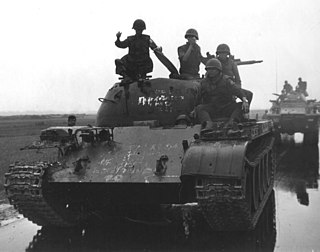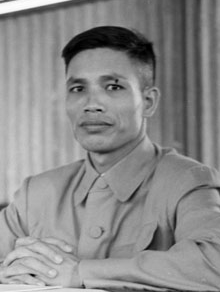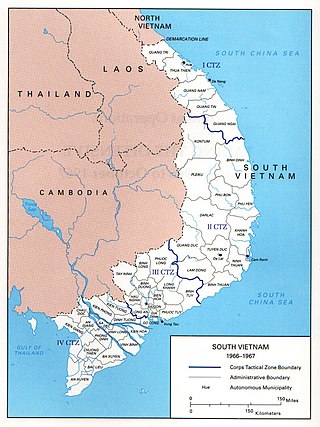Spring offensive may refer to:

The Vietnam War was a conflict in Vietnam, Laos, and Cambodia from 1 November 1955 to the fall of Saigon on 30 April 1975. It was the second of the Indochina Wars and was a major conflict of the Cold War. While the war was officially fought between North Vietnam and South Vietnam, the north was supported by the Soviet Union, China, and other communist states, while the south was supported by the United States and other anti-communist allies, making the war a proxy war between the United States and the Soviet Union. It lasted almost 20 years, with direct U.S. military involvement ending in 1973. The conflict also spilled over into neighboring states, exacerbating the Laotian Civil War and the Cambodian Civil War, which ended with all three countries officially becoming communist states by 1976.

Võ Nguyên Giáp was a militarily self-taught general of the People's Army of Vietnam (PAVN), communist revolutionary and politician. Regarded as one of the greatest military strategists of the 20th century, Giáp commanded Vietnamese communist forces in various wars. He served as the military commander of the Việt Minh and later the PAVN from 1941 to 1972, as the minister of defence of the Democratic Republic of Vietnam and later Socialist Republic of Vietnam in 1946–1947 and from 1948 to 1980, and as deputy prime minister from 1955 to 1991. He was also a member of the Politburo of the Communist Party of Vietnam.

Hồ Chí Minh, colloquially known as Uncle Ho or just Uncle (Bác), and by other aliases and sobriquets, was a Vietnamese communist revolutionary, nationalist, and politician. He served as Prime Minister of the Democratic Republic of Vietnam from 1945 to 1955, and as President from 1945 until his death in 1969. Ideologically a Marxist–Leninist, he was the Chairman and First Secretary of the Workers' Party of Vietnam, the predecessor of the current Communist Party of Vietnam.

The Viet Cong was an epithet to call the communist movement and united front organization in South Vietnam, Laos and Cambodia. Formally organized as and led by the National Liberation Front of South Vietnam, it fought under the direction of North Vietnam against the South Vietnamese and United States governments during the Vietnam War. The organization had both guerrilla and regular army units, as well as a network of cadres who organized and mobilized peasants in the territory the Viet Cong controlled. During the war, communist fighters and some anti-war activists claimed that the Viet Cong was an insurgency indigenous to the South, while the U.S. and South Vietnamese governments portrayed the group as a tool of North Vietnam. According to Trần Văn Trà, the Viet Cong's top commander, and the post-war Vietnamese government's official history, the Viet Cong followed orders from Hanoi and were practically part of the People's Army of Vietnam, or North Vietnamese army.

Lê Đức Thọ, born Phan Đình Khải in Nam Dinh Province, was a Vietnamese revolutionary general, diplomat, and politician. He was the first Asian to be awarded the Nobel Peace Prize, jointly with United States Secretary of State Henry Kissinger in 1973, but refused the award.

William Childs Westmoreland was a United States Army general, most notably commander of United States forces during the Vietnam War from 1964 to 1968. He served as Chief of Staff of the United States Army from 1968 to 1972.

The Tet Offensive was a major escalation and one of the largest military campaigns of the Vietnam War. The Viet Cong (VC) and North Vietnamese People's Army of Vietnam (PAVN) launched a sneak attack on January 30, 1968, against the forces of the South Vietnamese Army of the Republic of Vietnam (ARVN), the United States Armed Forces and their allies. It was a campaign of surprise attacks against military and civilian command and control centers throughout South Vietnam. The name is the truncated version of the Lunar New Year festival name in Vietnamese, Tết Nguyên Đán, with the offense chosen during a holiday period as most ARVN personnel were on leave. The purpose of the wide-scale offensive by the Hanoi Politburo was to trigger political instability, in a belief that mass armed assault on urban centers would trigger defections and rebellions.

The First Indochina War was fought between France and Việt Minh, and their respective allies, from 19 December 1946 until 20 July 1954. Việt Minh was led by Võ Nguyên Giáp and Hồ Chí Minh. Most of the fighting took place in Tonkin in Northern Vietnam, although the conflict engulfed the entire country and also extended into the neighboring French Indochina protectorates of Laos and Cambodia.

The Easter Offensive, also known as the 1972 spring–summer offensive by North Vietnam, or the Red Fiery Summer as romanticized in South Vietnamese literature, was a military campaign conducted by the People's Army of Vietnam against the Army of the Republic of Vietnam and the United States military between 30 March and 22 October 1972, during the Vietnam War.

The Paris Peace Accords, officially the Agreement on Ending the War and Restoring Peace in Viet Nam, was a peace agreement signed on January 27, 1973, to establish peace in Vietnam and end the Vietnam War. The agreement was signed by the governments of the Democratic Republic of Vietnam ; the Republic of Vietnam ; the United States; and the Provisional Revolutionary Government of the Republic of South Vietnam (PRG), which represented South Vietnamese communists. US ground forces had begun to withdraw from Vietnam in 1969, and had suffered from deteriorating morale during the withdrawal. By the beginning of 1972 those that remained had very little involvement in combat. The last American infantry battalions withdrew in August 1972. Most air and naval forces, and most advisers, also were gone from South Vietnam by that time, though air and naval forces not based in South Vietnam were still playing a large role in the war. The Paris Agreement removed the remaining US forces. Direct U.S. military intervention was ended, and fighting between the three remaining powers temporarily stopped for less than a day. The agreement was not ratified by the U.S. Senate.

Operation Linebacker was the codename of a U.S. Seventh Air Force and U.S. Navy Task Force 77 air interdiction campaign conducted against North Vietnam from 9 May to 23 October 1972, during the Vietnam War.
The Indochina Wars were a series of wars which were waged in Southeast Asia from 1946 to 1992, by communist Indochinese forces against the opponents. The term "Indochina" originally referred to French Indochina, which included the current states of Vietnam, Laos, and Cambodia. In current usage, it applies largely to a geographic region, rather than to a political area. The wars included:

Quảng Trị is a coastal province near the southernmost part of the North Central Coast region, the Central of Vietnam, north of the former imperial capital of Huế. It borders Quảng Bình to the north, Thừa Thiên Huế to the south, Savannakhet of Laos to the west and the East Sea to the east, with 75 kilometres (47 mi) of coast.

Văn Tiến Dũng, born in Co Nhue commune, Từ Liêm District, Hanoi, was a Vietnamese general in the People's Army of Vietnam (PAVN), PAVN chief of staff (1954–74); PAVN commander in chief (1974–80); member of the Central Military–Party Committee (CMPC) (1984–86) and Socialist Republic of Vietnam defense minister (1980–87).
The Three Alls policy was a Japanese scorched earth policy adopted in China during World War II, the three "alls" being "kill all, burn all, loot all". This policy was designed as retaliation against the Chinese for the Communist-led Hundred Regiments Offensive in December 1940.
United States involvement in the Vietnam War began shortly after the end of World War II in Asia, first in an extremely limited capacity and escalating over a period of 20 years. The U.S. military presence peaked in April 1969, with 543,000 American combat troops stationed in Vietnam. By the conclusion of the United States's involvement in 1973, over 3.1 million Americans had been stationed in Vietnam.

USS Bolster (ARS-38) was a Bolster-class rescue and salvage ship acquired by the U.S. Navy during World War II and remained in service during the Korean War and the Vietnam War. Her task was to come to the aid of stricken vessels.
Winter Offensive or variation may refer to:

During the Cold War in the 1960s, the United States and South Vietnam began a period of gradual escalation and direct intervention referred to as the "Americanization" of joint warfare in South Vietnam during the Vietnam War. At the start of the decade, United States aid to South Vietnam consisted largely of supplies with approximately 900 military observers and trainers. After the assassination of both Ngo Dinh Diem and John F. Kennedy close to the end of 1963 and Gulf of Tonkin incident in 1964 and amid continuing political instability in the South, the Lyndon Johnson Administration made a policy commitment to safeguard the South Vietnamese regime directly. The American military forces and other anti-communist SEATO countries increased their support, sending large scale combat forces into South Vietnam; at its height in 1969, slightly more than 400,000 American troops were deployed. The People's Army of Vietnam and the allied Viet Cong fought back, keeping to countryside strongholds while the anti-communist allied forces tended to control the cities. The most notable conflict of this era was the 1968 Tet Offensive, a widespread campaign by the communist forces to attack across all of South Vietnam; while the offensive was largely repelled, it was a strategic success in seeding doubt as to the long-term viability of the South Vietnamese state. This phase of the war lasted until the election of Richard Nixon and the change of U.S. policy to Vietnamization, or ending the direct involvement and phased withdrawal of U.S. combat troops and giving the main combat role back to the South Vietnamese military.

USS Sumner County (LST-1148) was a LST-542-class tank landing ship in the United States Coast Guard during World War II.